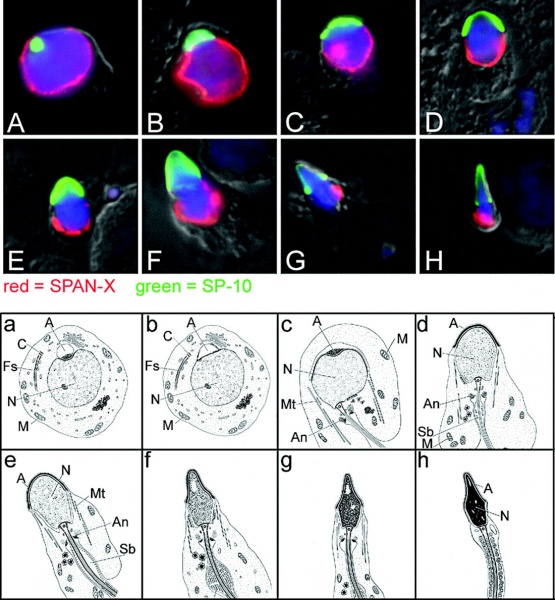File:Human spermatozoa acrosomal protein SP-10.jpg

Original file (1,100 × 1,189 pixels, file size: 239 KB, MIME type: image/jpeg)
Human Spermatozoa Acrosomal Protein SP-10
Immunofluorescent/differential interference contrast (DIC) micrographs (A–H) and diagrammatic representations (a–h; modified from Holstein and Roosen-Runge, 1981) of enzyme-dissociated human testicular cells.
Occasional nuclear vacuoles demonstrating SPANXa/d staining are observed (B and C, arrows). × 1250 |
Legend
Labels
|
- Links: Spermatozoa Development
Reference
<pubmed>17012309</pubmed>| Mol Hum Reprod.
Copyright
© The Author 2006. Published by Oxford University Press on behalf of the European Society of Human Reproduction and Embryology. All rights reserved. For Permissions, please email: journals.permissions@oxfordjournals.org
The online version of this article has been published under an open access model. Users are entitled to use, reproduce, disseminate, or display the open access version of this article for non-commercial purposes provided that: the original authorship is properly and fully attributed; the Journal and Oxford University Press are attributed as the original place of publication with the correct citation details given; if an article is subsequently reproduced or disseminated not in its entirety but only in part or as a derivative work this must be clearly indicated. For commercial re-use, please contact journals.permissions@oxfordjournals.org
Only Figure 6. from the original article is displayed here.
File history
Click on a date/time to view the file as it appeared at that time.
| Date/Time | Thumbnail | Dimensions | User | Comment | |
|---|---|---|---|---|---|
| current | 15:07, 1 November 2010 |  | 1,100 × 1,189 (239 KB) | S8600021 (talk | contribs) | ==Human Spermatozoa Acrosomal Protein SP-10== Immunofluorescent/differential interference contrast (DIC) micrographs (A–H) and diagrammatic representations (a–h; modified from Holstein and Roosen-Runge, 1981) of enzyme-dissociated human testicular cel |
You cannot overwrite this file.
File usage
The following 2 pages use this file: